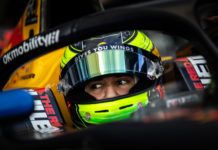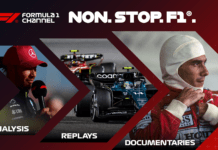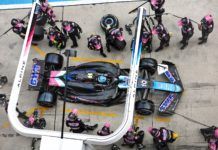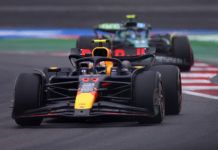James Vowles goes through the strategy options that Mercedes had during the F1 US GP as he dissects how Lewis Hamilton’s race panned out.
It was quite the strategic F1 US GP and Mercedes fell short to Red Bull’s aggressiveness as Max Verstappen took the win over Hamilton to extend his points advantage in the 2021 season. Even though they had the tyre advantage, it wasn’t enough in the end.
In their usual post-race debrief, Mercedes strategy director Vowles goes through the explanation of why they didn’t go for an undercut knowing how useful it will be. He also talks about early second stop and if medium tyres was possible in the final stint.
Undercut:
Vowles: “It is always a trade-off between stopping early in terms of the traffic behind you and not running out of tyres before the end of the race. In other words, optimising your stints. The fastest two stop race is actually stopping round about 14 or 15. So anything you are doing shorter than that is costing you race time, is making the entire race slower. Now, that may not matter as long as you have track position. Stopping where they did on lap ten is clearly a compromise, but they obviously were very, very quick.
“On that first stint of the race on the Medium tyre, we had Verstappen seven tenths behind us all stint and we were degrading quite quickly. What that means is you don’t have certainty that the Hard tyre was going to be much different to that and you are trying to predict forward how the Hard tyre will perform. You saw with Verstappen, he ran out of tyres on that second stint and he ran out of tyres end of race. What they did was to a certain extent a gamble. They were in second position anyway so why not take some risks? The reason for us not stopping that early on is twofold.
“First, we would have come out right on top of Ricciardo and we would have been compromised through the Esses until we got past past him probably on the run down to Turn 12 and that would have cost us time. Maybe not enough to not hold on to that lead position but it would have cost us time. The second is, Red Bull would have then gone very long, as we did, but they did have two cars so they didn’t have the pressure to then stop and they were fast on that first stint on Medium and that could have made us into a very compromised position later in the race.
“So, from our perspective we knew the early stop was good and we had highlighted that just the lap Ricciardo pulled out of our window, which probably would have been lap eleven, would be the right point but what Red Bull did was take a gamble. They didn’t mind if they had to convert to a three stop, ultimately Verstappen would have finished second anyway bit we did. That would have put us behind Perez. So, ultimately, it’s a balance between making sure your first stint is long enough, that you are not dropping off the tyre curve on stint two and stint three because a team that can go longer than you will ultimately beat you if they have car pace.
“Another decision point in the race is whether or not we could have aggressively undercut Red Bull on stint two of the race. Verstappen was just over three seconds ahead and the answer to that is, it was very marginal, but we had highlighted that the undercut wouldn’t be enough. If we were to stop, they will cover us the next lap and Lewis will still end up in P2 but now you have lost all tactical options because both cars were on the same stint to the end of the race. So, we had decided that our best opportunity was to force them in or if we can get within two seconds we’ll go for the undercut. That didn’t happen, Verstappen stopped, and the rest is history.”
If medium tyres for last stint:
Vowles: “All the way through the race we are continuously building up tyre models. We have an understanding of how they are all performing to each other, the Soft, the Medium, the Hard. Not just from ourselves but from our competitors as well. What was very clear is that the Medium was a very poor tyre for us. On that first stint of the race, we were quite slow. I would say probably in the region of over half a second off what we could do on the Hard. And that became an easy decision for ourselves.
“I think it would have been more difficult with other cars but given our situation and given that we know that we were poor in stint one of the race, it wasn’t an option to fit the Medium again. The degradation would have been too high and Lewis, whilst would have still caught Verstappen, wouldn’t have had the tyre to even have a go at the end.”
Early second stop:
Vowles: “Answering that question directly first of all, one lap or two laps earlier he still end of race would have tyres that allow him to approach Verstappen but I doubt it would have allowed him to overtake. To explain that in more detail, there is a compromise, clearly. For every lap that you go shorter end of race your tyres will be one lap younger and the tyre degrades, every lap you put onto a tyre, every time you roll around five kilometres it takes an amount of performance out of that tyre. So, one lap earlier means at the end of the race your tyre will be a tenth maybe a bit more slower than it would have been.
“And to generate on overtake, you need a bigger and bigger tyre differential between you and the car that you are fighting. One part of that that we can control is our degradation and what lap we stop on, the second that we can’t is what Verstappen’s degradation is and where he falls of the tyre curve. Now, he was predicted to fall off the tyre curve and he did but he only did that on the very last lap of the race. Had that happened a lap or two earlier, I think you would have seen a different race result, but they managed that last stint very well and dropped the level of management in corners as Lewis got closer to them to make sure he had the tyres remaining for those last few laps.
“If we had gone a lap or two earlier a few things would have happened. Verstappen would have been closer on pit exit. He is on fresher tyres, so for every lap he has been going relative to Lewis he is actually pulling just a little bit of a gap on track and when Lewis stops, he has to push back into back up, he has to basically catch back up to Verstappen and if the gap is too large, let’s take it to an exaggerated level, 15 seconds, he will use all his tyres back up closing that gap down and there is nothing left in the race. So that’s where the compromise lies, what you want is to find the lap that minimises the gap on exit and maximises the differential therefore end of race. And when we stopped was that, in terms of the models. It’s difficult to really know what would have happened if we stopped a lap earlier or lap later, but what you are reliant on really for the strategy to work is Verstappen to run out of tyres and they didn’t really do that until it was too late.”
In a strategic race like this, the role of Vowles becomes crucial. He is not alone in decision making though, as he has the able support of the race engineers plus the team boss and also the team at Brackley, who are continuously churning numbers.
Wolff: “So there is a great group of people in Brackley who obviously have all of the tools and math behind it. And that is being discussed on the strategy channel between the Brackley base and James, and the pit wall and myself. And it’s a brainstorming, and I need to be, so I’m very involved in the decision-making process in terms of they run, James runs his strategy thinking past me, and I would only, how can I say, give the feedback that I have because I have more bandwidth.
“I’m not looking at the specific data channel, but I’m able to look at the intercom, the audio messaging from the other team and obviously how the race pans out. I have James and Bradley next to me who are very experienced as well, and we are the sounding board, and the sparring partner for James, and we’re pretty active in terms of how the strategy then pans out.”
Here’s Max Verstappen, Lewis Hamilton plus Toto Wolff and Christian Horner on US GP
Here’s Max Verstappen and Lewis Hamilton on Turn 1



















